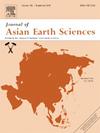热带新特提斯西部始新世富脊椎动物海相沉积物(Lutetian)的生物多样性和古环境:来自阿拉伯地台的新见解
IF 2.7
3区 地球科学
Q2 GEOSCIENCES, MULTIDISCIPLINARY
引用次数: 0
摘要
沙特阿拉伯达曼组始新世沉积以潮间带-浅海相碳酸盐岩与米级页岩(Midra和Saila页岩)互层为特征。后者可以追溯到始新世中期,包括大量的海洋脊椎动物,主要是板齿目动物(鲨鱼、鳐鱼和鳐鱼)的牙齿。丰富的化石组合包括至少13个板鳃科分类群(包括8个不同的鲨鱼和3个蝙蝠形分类群)和至少7个硬骨鱼类分类群。这一组合首次在阿拉伯地台(新特提斯的西缘)被描述,对了解始新世特提斯周围海洋生物的变化至关重要。较大的板形鲨科主要是板形鲨,如“Carcharias”koerti, Brachycarcharias cf. lerichei和Striatolamia cf. macrota,以及虎鲨Galeocerdo eaglesomei,锤头鲨Sphyrna sp.和myliobatoids。硬骨鱼种类较少,主要是Eotrigonodon和Pycnodus。底栖动物群的多样性较低,包括双壳类、腹足类、棘皮类和珊瑚,以及浅海板鳃纲和硬骨鱼类群。本研究发现的鱼类组合与世界上其他中始新世动物群一致,特别是在热带新特提斯海道。生物地层学分析和牙釉质体的锶同位素比值测定证实了一个鲁特时代(可能精确到中期鲁特时代)。在沙特阿拉伯发现的各种分类群使我们能够初步重建各种化石群与其广泛的古环境之间可能的相互作用。以大型板形和狐形鲨鱼为特征的顶级掠食者可能在其他鱼类(包括鹰鳐、地毯鲨、锯鱼和硬骨鱼)栖息的近岸浅水中捕猎。本文章由计算机程序翻译,如有差异,请以英文原文为准。

Biodiversity and paleoenvironments of vertebrate-rich Eocene marine deposits (Lutetian) of the tropical western Neotethys: New insights from the Arabian Platform
The Eocene deposits of Saudi Arabia (Dammam Formation) are characterized by intertidal to shallow marine carbonate rocks interbedded with meter-scale shale members (Midra and Saila shales). The latter are dated from the middle Eocene and include large numbers of marine vertebrates, dominated by elasmobranch (sharks, skates, and rays) teeth. The rich fossil assemblage comprises at least 13 elasmobranch taxa (including 8 different sharks and 3 batomorph taxa) and at least 7 bony fish taxa. This assemblage is described for the first time from the Arabian Platform (western margin of the Neotethys) and is critically important to understand the changes in circum Tethyan marine biotas during the Eocene. The larger elasmobranchs are dominated by lamniform sharks, such as “Carcharias” koerti, Brachycarcharias cf. lerichei and Striatolamia cf. macrota, along with the tiger shark Galeocerdo eaglesomei, the hammerhead shark Sphyrna sp., and myliobatoids. Teleost fishes appear less diversified in the area and are dominated by Eotrigonodon and Pycnodus species. A low-diversity benthic fauna including bivalves, gastropods, echinoids and corals was found along with the neritic elasmobranch and teleost taxa. The fish assemblage found in the present study is consistent with other middle Eocene faunas worldwide, especially in the tropical Neotethys seaway. Biostratigraphic analyses and strontium isotope ratio measurements from tooth enameloid confirm a Lutetian age (possibly refined to mid-Lutetian). The variety of taxa recovered in Saudi Arabia enables a preliminary reconstruction of the likely interactions between the various fossil groups and their broad paleoenvironments. Apex predators characterized by large lamniform and carcharhiniform sharks probably hunted in shallow near shore waters, where other fish (including eagle rays, carpet sharks, sawfish, and bony fish) were dwelling.
求助全文
通过发布文献求助,成功后即可免费获取论文全文。
去求助
来源期刊

Journal of Asian Earth Sciences
地学-地球科学综合
CiteScore
5.90
自引率
10.00%
发文量
324
审稿时长
71 days
期刊介绍:
Journal of Asian Earth Sciences has an open access mirror journal Journal of Asian Earth Sciences: X, sharing the same aims and scope, editorial team, submission system and rigorous peer review.
The Journal of Asian Earth Sciences is an international interdisciplinary journal devoted to all aspects of research related to the solid Earth Sciences of Asia. The Journal publishes high quality, peer-reviewed scientific papers on the regional geology, tectonics, geochemistry and geophysics of Asia. It will be devoted primarily to research papers but short communications relating to new developments of broad interest, reviews and book reviews will also be included. Papers must have international appeal and should present work of more than local significance.
The scope includes deep processes of the Asian continent and its adjacent oceans; seismology and earthquakes; orogeny, magmatism, metamorphism and volcanism; growth, deformation and destruction of the Asian crust; crust-mantle interaction; evolution of life (early life, biostratigraphy, biogeography and mass-extinction); fluids, fluxes and reservoirs of mineral and energy resources; surface processes (weathering, erosion, transport and deposition of sediments) and resulting geomorphology; and the response of the Earth to global climate change as viewed within the Asian continent and surrounding oceans.
 求助内容:
求助内容: 应助结果提醒方式:
应助结果提醒方式:


